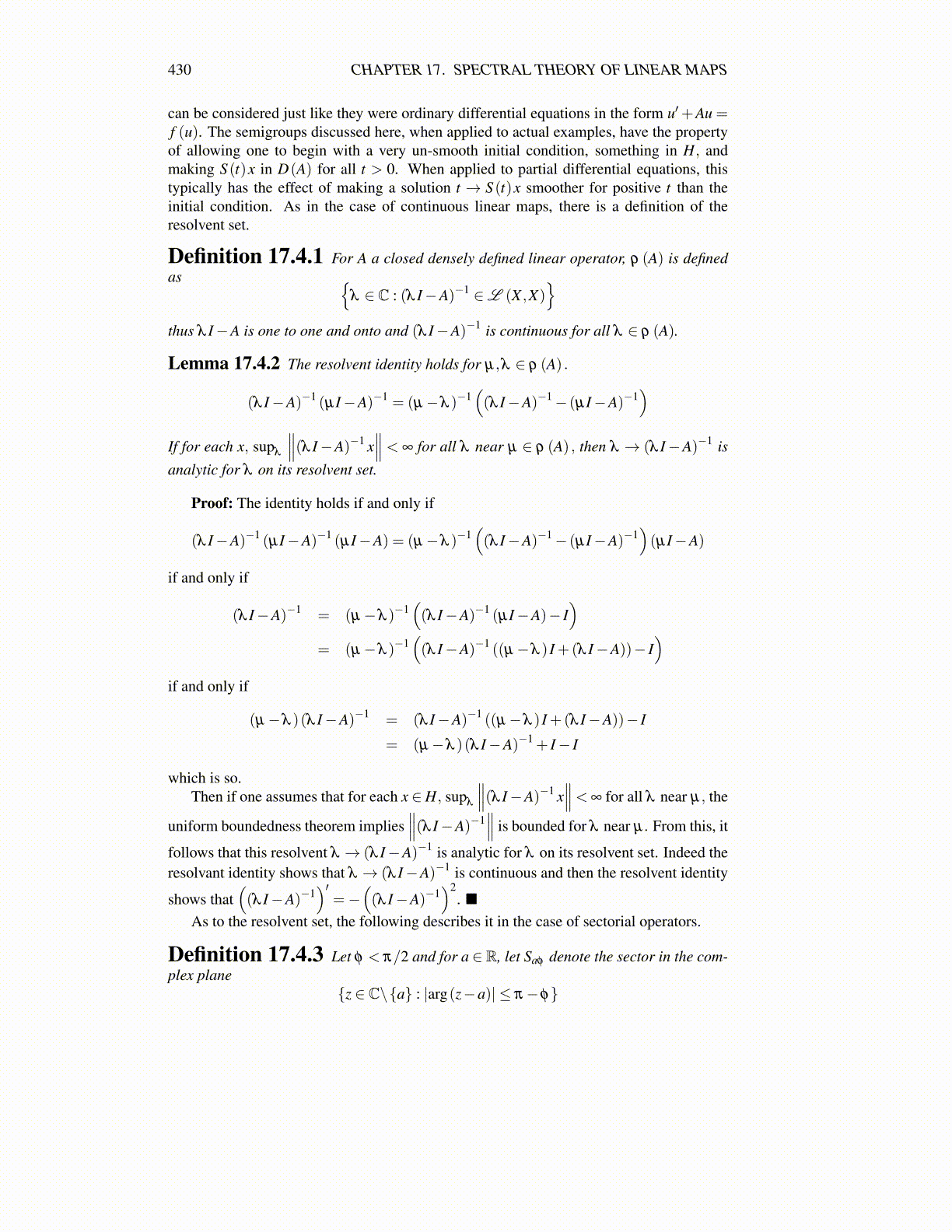
430 CHAPTER 17. SPECTRAL THEORY OF LINEAR MAPS
can be considered just like they were ordinary differential equations in the form u′+Au =f (u). The semigroups discussed here, when applied to actual examples, have the propertyof allowing one to begin with a very un-smooth initial condition, something in H, andmaking S (t)x in D(A) for all t > 0. When applied to partial differential equations, thistypically has the effect of making a solution t → S (t)x smoother for positive t than theinitial condition. As in the case of continuous linear maps, there is a definition of theresolvent set.
Definition 17.4.1 For A a closed densely defined linear operator, ρ (A) is definedas {
λ ∈ C : (λ I−A)−1 ∈L (X ,X)}
thus λ I−A is one to one and onto and (λ I−A)−1 is continuous for all λ ∈ ρ (A).
Lemma 17.4.2 The resolvent identity holds for µ,λ ∈ ρ (A) .
(λ I−A)−1 (µI−A)−1 = (µ−λ )−1((λ I−A)−1− (µI−A)−1
)If for each x, supλ
∥∥∥(λ I−A)−1 x∥∥∥ < ∞ for all λ near µ ∈ ρ (A) , then λ → (λ I−A)−1 is
analytic for λ on its resolvent set.
Proof: The identity holds if and only if
(λ I−A)−1 (µI−A)−1 (µI−A) = (µ−λ )−1((λ I−A)−1− (µI−A)−1
)(µI−A)
if and only if
(λ I−A)−1 = (µ−λ )−1((λ I−A)−1 (µI−A)− I
)= (µ−λ )−1
((λ I−A)−1 ((µ−λ ) I +(λ I−A))− I
)if and only if
(µ−λ )(λ I−A)−1 = (λ I−A)−1 ((µ−λ ) I +(λ I−A))− I
= (µ−λ )(λ I−A)−1 + I− I
which is so.Then if one assumes that for each x ∈H, supλ
∥∥∥(λ I−A)−1 x∥∥∥< ∞ for all λ near µ, the
uniform boundedness theorem implies∥∥∥(λ I−A)−1
∥∥∥ is bounded for λ near µ . From this, it
follows that this resolvent λ → (λ I−A)−1 is analytic for λ on its resolvent set. Indeed theresolvant identity shows that λ → (λ I−A)−1 is continuous and then the resolvent identity
shows that((λ I−A)−1
)′=−
((λ I−A)−1
)2. ■
As to the resolvent set, the following describes it in the case of sectorial operators.
Definition 17.4.3 Let φ < π/2 and for a ∈R, let Saφ denote the sector in the com-plex plane
{z ∈ C\{a} : |arg(z−a)| ≤ π−φ}